Archive for ‘Emergency’ Category
How to Replace and Organize 7 Essential Government Documents
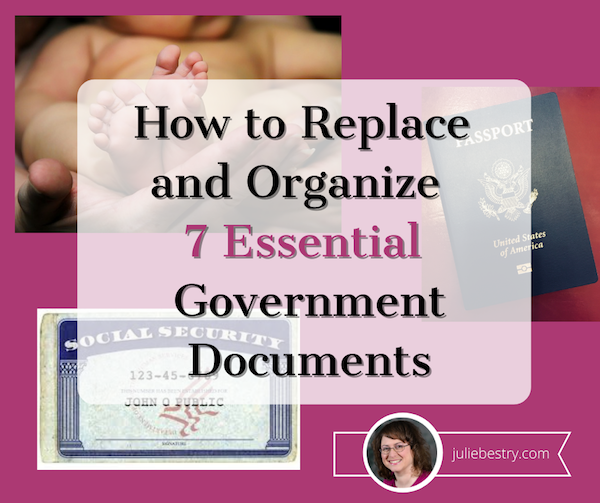
All documents are not created equal. If you lose your electric bill, you can log into your account, and then view, pay, and even print a copy of your bill. Other items fall into the Very Important Paper, or VIP, category, and require more effort to replace. These are the documents without which we cannot pass GO or collect 200 (or any) dollars unless we present an original, certified copy.
The Search for Vital Documents
While stuck at home, numerous clients and friends have been reporting on the states of their files and important documents.
A few months ago, in anticipation of the world returning to “normal,” a client wanted to make plans for a big post-quarantine trip. Although she hasn’t traveled outside of the country in decades, quarantine left her feeling claustrophobic and she’s eager to explore the world. But her passport is both expired and (unfortunately) missing.
Elsewhere, a reader had seen my blog post, Paper Doll On Narwhals, Fake News, and How To Get A REAL ID from last February, and wanted to get a REAL ID so she’d be able to fly domestically. (As a reminder, that deadline has change from October 2020 to October 2021.)
Both would need their birth certificates. Like many people, neither had needed one since applying for driver’s licenses as teens. One couldn’t find hers; yes, that was the one who also lost her passport. The other knew it was somewhere in her elderly parents’ home but couldn’t risk traveling during COVID to acquire it, nor could she accurately direct her parents to find it or trust the (lately chaotic) postal service to deliver the vital document if it were found.
Another client had received a notice that a company related to one of her late father’s stock holdings had liquidated, and the remaining value had been escheated. This means that having lost sight of his correct address when he moved from his longtime home to a nursing home, the transfer agent for the stock sent the check to his state’s unclaimed property division. To prove that she had a right to that amount, my client had to provide the state with her father’s death certificate and a copy of the will, showing that she was a beneficiary.
When my own father died, to prove Paper Mommy‘s right to certain veteran’s survivor benefits, we had to provide his military separation papers dating from World War II. Luckily, I had located these during the process that went into writing The Great Mesozoic Law Office Purge of 2015: A Professional Organizer’s Family Tale.
Replacing the Documents
As a Certified Professional Organizer, I’m often working with clients, sorting through random piles of papers. Wedged between expired car insurance declaration pages and outdated kindergarten registration paperwork, I’ll find some essential VIP and a client will exclaim, “I’ve been LOOKING for that!”
Whether you want to get benefits or insurance, travel or remarry, obtain a job or live happily ever after (whatever that means to you), you’re going to need to produce certain government documents. And if you don’t have them, you’ll need to replace them to make life easier for yourself and your loved ones.
1) Birth Certificate
You’re reading this, so you’ve already been born. (I mean, unless you’re a time traveler, in which case, howdy, and please leave a comment below about the winner and score of the upcoming Super Bowl!) Further, as you were born in the 20th (or 21st) century, you almost certainly already have a birth certificate, even if it’s not in your possession.
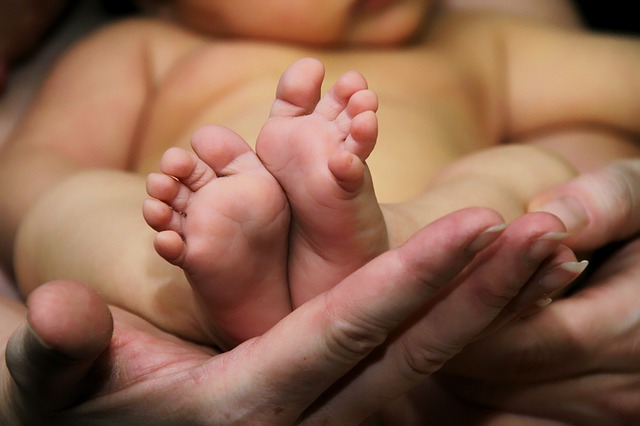
Image by Bruno /Germany from Pixabay
Why you need one: A birth certificate is not merely proof of your arrival on the planet. You need one to get a driver’s license, apply for Social Security and other government benefits owed to you, obtain a passport, join the military, and perhaps prove the date and location of your birth to show you are eligible to be a congressperson, senator, or President of the United States.
Usually, a photocopy will not suffice; you’ll need an embossed (bumpy) certificate, stamped by a government entity related to your place of birth. That might be your county clerk, the registrar of records, or someone else.
If you were born in the United States, contact the office of vital records for your state or territory of birth in writing.
First, visit the Center for Disease Control and Prevention’s National Center for Health Statistics. Through that site, you’ll find information regarding to whom (and at what address) you must write, the fee schedule (for as many copies as you need, plus postal and processing charges), and what information or proof you’ll need to submit. Fees are determined by locale; to get copy of a birth certificate from Guam, it’s only $5; for New York State (outside of New York City), it’s $30. (For New York City, it’s $15, which this Buffalonian considers an unfair discount.)
If you were born abroad to American parents, your birth would have been registered with your nation of birth’s embassy or consulate. If everything is hunky-dory, instead of a standard birth certificate, they would have been given Consular Report of Birth Abroad (CRBA) and you can request a copy from the U.S. Department of State. If they can’t locate your CRBA, or your birth wasn’t registered with an embassy, but you were born on a military base, you can try to contact the hospital where you were born.
If you were born abroad, even if you were adopted by a family in the United States, you won’t have an original U.S. birth certificate; you’ll have to contact the nearest embassy for that nation for assistance. If you were born “on the high seas,” on an aircraft, or in the Panama Canal Zone, you’ll want to read this page for special guidance. (You’ll also want to record your mom telling the story of how that came to be for the delight and amazement of future generations!)
If you were born in Canada, contact the vital statistics office for your province of birth.
To replace your birth certificate, be prepared to provide identifying details, including:
- your full name at birth
- date of birth
- sex (as assigned at birth)
- county and/or city of birth
- hospital name
- your *mother’s complete (including maiden) name, and
- your *father’s complete name
*In the future, it will be more likely that birth certificates will indicate parents names without assuming parents of two genders; currently, however, most locales show these as gendered categories.
You’ll also have to supply your signature (possibly notarized, depending on your state’s requirements), your mailing address, and your phone number.
If you are pressed for time, there are third-party services, like Vitalchek, that can expedite the process for an added cost. (Be sure to do a deep-dive to verify that any expediting service is on the up-and-up.)
2) Social Security Card
Why you need one: You need proof of your registration with the Social Security Administration in order to get a job, accrue benefits, and receive certain government services. Your parents probably completed the paperwork for your Social Security card when you were a newborn, so like a birth certificate, someone has already done the hard work for you. (If you are over the age of 12 but have never received a Social Security card, you will have to apply in person at your local Social Security office.)
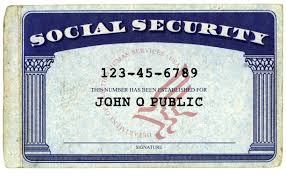
You should already have your Social Security card; you would have needed it to apply for your first “grownup” job. However, if you’ve lost it at some point, you can replace it in one of two ways.
The standard method is by completing an SS-5 application, available online at the Social Security Administration’s website. You will have to print the application and then mail it to your local Social Security office. And that’s the first wrinkle – the Social Security Administration halted all face-to-face services and closed their field offices on March 20, 2020 and they have not yet resumed services. Their website states, “However, we are still able to provide critical services via phone, fax and online.”
Happily, you can replace your Social Security card online, provided that you have (or are willing to create) a mySocialSecurity account.
You’ll be happy to know that unlike a birth certificate, driver’s license, or almost any other official document, you can get your replacement Social Security card for free! However, this isn’t a “Get out of jail, free” card for keeping your paperwork disorganized. You are limited to three replacements per year and ten in your lifetime. (Questions #11 and #12 on the application refer to replacing cards for pre-existing Social Security numbers/cards.)
Remember, don’t carry your Social Security card around with you. That’s like carrying a one million dollar bill, and puts you at risk of identity theft. Unless you have been asked to provide your card for an official reason, such as when you are meeting with Human Resources at your new job, keep your card in a safe place, like your fireproof safe at home.
3) Marriage License & Certificate
Are you married? Mazel tov! But do you know where your marriage license and certificate are?
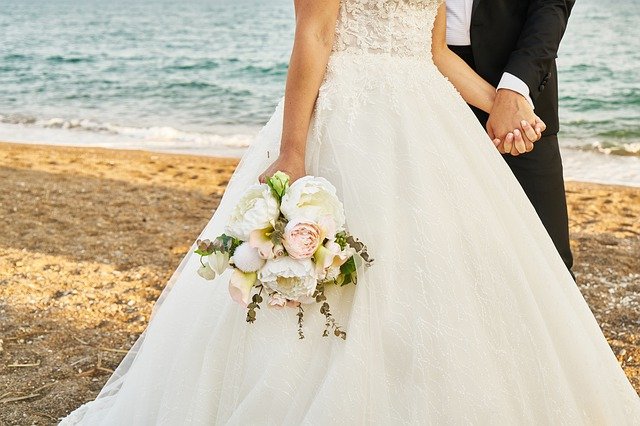
Image by Engin Akyurt from Pixabay
Why you need one (of each): Every state requires a marriage license, the paper that legally authorizes you to get married, and a marriage certificate, to prove the deed has been done. You apply for a marriage license at some point prior to when you expect the ceremony to be. However, depending on your state, your license might expire anywhere from 30 days to a year after you receive it.
Let’s say you got your marriage license on March 1, 2020, expecting to get married two months later, on May 1, 2020. And let’s say licenses in your state don’t expire for six months. Normally, you wouldn’t be too worried. But perhaps due to COVID, your wedding got postponed and your license expired. No problem; you just apply for a new one.
But let’s say that someone accidentally loses your marriage license, or it got accidentally destroyed after the wedding ceremony but before you were able to submit it to your county. (If it wasn’t accidental, Paper Doll suggests couples counseling.) If that happens, you need the officiant (the minister, priest, rabbi, judge, etc. – the person who officiated) to intervene on your behalf. The officiant has to contact the license-issuing office to get a get a duplicate to ensure that your marriage is kosher.
So, your marriage license is what you need in order to get married; a marriage certificate is proof that the marriage ceremony has happened. If you are taking your new spouse’s name, you will need your marriage certificate in order to legally change your name on your driver’s license, passport, and other official documents.
If your name differs from your spouse, proving your legal right to visit in the hospital may be difficult without documentation. (Granted, during COVID, in many places, visitors – even spouses – are not allowed in hospitals right now.) Insurance companies might require a copy of the certificate to provide spousal coverage, and proof of your marriage is required for everything from qualifying for military housing to obtaining pension benefits to adoption and travel abroad.
The point is that unless you are a character on Grey’s Anatomy, a Post-It Note of marital promises isn’t going to cut it.

If you’re already married, but you trusted your spouse to file the marriage certificate safely away, and your spouse trusted you to do the same (great trust levels, not-so-great organizational skills), you can use the same CDC link provided for birth certificates to identify your state’s office of vital records and see the fees and requirements for requesting copies. You might also take this opportunity to speak with a professional organizer about the best system for organizing your family’s paperwork and maximize future joy.
4) Divorce Decree
Why you need one: Certified copies of divorce decrees are necessary if you wish to remarry, to provide proof of legally separate finances to a tax authority (like the IRS or the state) or a creditor, and to be a contestant on a TV show like The Bachelor. (But please, don’t do that.)
If you’ve lost your divorce decree paperwork and live in or near the county in which the divorce was granted, the fastest method will be to arrive at the county courthouse with the following information in hand:
- the full name of both spouses (including any maiden names) as of the wedding date
- the court case number
- the exact date of the divorce
- and the city, county, and state in which the divorce took place
If you don’t have the court case number, you will need to call one of attorney(s) and/or mediator who handled your divorce to see if their records include the case file number. With this information, you’ll be able to fill out an official request form at the courthouse.
If you no longer live in or near the county in which the divorce occurred, follow the CDC link for the state in which the divorce took place, and follow your individual locale’s instructions.
5) Military Separation/Discharge Papers
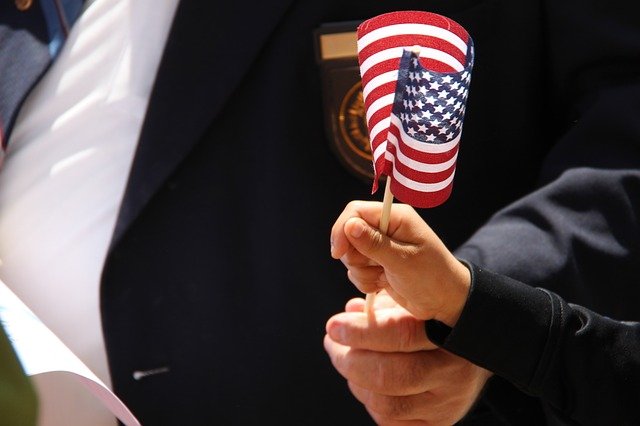
Image by Shonda Ranson from Pixabay
Why you need them: You’ll need your own military records and separation/discharge papers to obtain a job or a security clearance, get proof or copies of medals, or apply for medical or disability benefits. If a relative who served has died, you’ll need certified copies of these records to arrange a military funeral or obtain certain survivor’s benefits.
An original signature of the veteran (or his/her next of kin) is required to fill requests for copies of Official Military Personnel Files (OMPF). To a get a free copy of your (or your relative’s) Report of Separation (DD Form 214) or other military records, start with the electronic search/request system eVetRecs, or mail (or fax) a standard form SF-180 to the National Personnel Records Center.
And here’s where there’s another wrinkle.
Due to COVID, the National Personnel Records Center is closed except for emergencies, and they state on their site:
While we remain in this state, we will continue servicing requests associated with medical treatments, burials, and homeless veterans seeking admittance to a homeless shelter. Please refrain from submitting non-emergency requests such as replacement medals, administrative corrections, or records research until we return to pre-COVID staffing levels.
In other words, unless you are seeking a DD214 so that a veteran can get healthcare or space in a homeless shelter, or to facilitate a veteran’s burial, you may have to make a note on your “To Do After COVID” list for replacing these documents.
6) Death certificate
Why you need one: After someone dies, you will need multiple certified embossed copies of a death certificate for almost everything, including:
- canceling cell phone and utility contracts
- closing an estate
- transferring car titles
- notifying financial institutions regarding debts
- transferring ownership of tangible and intangible property to beneficiaries, and
- other legal, financial, and real estate transactions
If someone has recently died, it is easier and more convenient to acquire death certificates from the funeral home, which generally maintains ongoing relationships with local government offices. In most states, there is a standard fee for acquiring a death certificate, and ethical funeral homes should acquire and pass along requested copies of the death certificate charging an additional fee.
If you need to acquire a death certificate for someone whose passing was not recent, and getting the assistance of the funeral home is not applicable, the procedure is similar to other obtaining copies of birth and marriage certificates. Select your state from the CDC listings for your Office of Vital Records and follow the instructions for your state.
7) Passport
Right now, international travel is an iffy proposition and even where travelers are welcome, many new rules abound, but it can’t help to dream about traveling the globe when all is calm again.
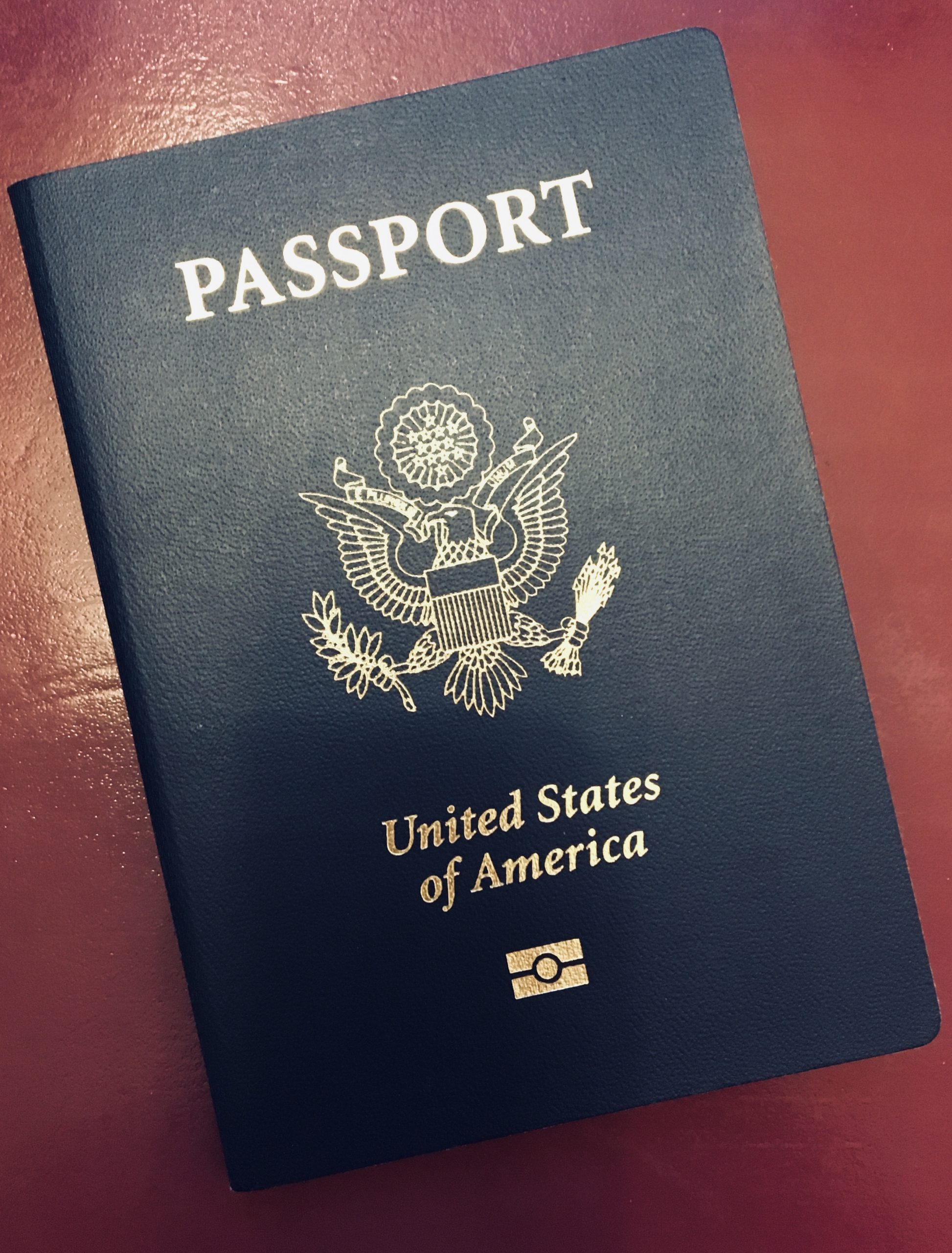
Applying for a new passport still requires some of the process to be completed in person. However, much can be accomplished online, including downloading forms, calculating fees, and getting information about your passport’s application status.
To apply for a new passport, download form DS-11 and read the general instructions at the Department of State web site.
If your passport is lost or stolen, you’ll have to report it. Fill out a DS-64 and then submit it, along with a DS-11, to get a replacement.
To renew your passport by mail, whether it has expired or not, fill out a DS-82 and submit it, along with your old, undamaged passport and required documentation. However, if your expired passport is more than 15 years old, you will have to apply for a new one; if your prior passport was issued before you reached the age of 16, you will have to apply anew. And, you may only renew your passport if it was issued in your current name; or if you can provided legal proof of your name change.
The Department of State has a section explaining delays related to COVID.
What to Do When You Get Your Replacement Documents
Once you spend time and effort replacing a government document, you don’t want to have to do it again. Do the following:
- Scan a copy of your vital documents.
- Provide a scanned and/or paper copy of each of these vital documents to a trusted friend or relative so that if your copies are damaged in a fire or natural disaster, you will at least have some guidance regarding the information contained in them.
- Place your official, embossed (bumpy) paper copies somewhere safe and logical, like a fireproof safe. If you have multiple copies, you can keep extras in a VIP folder of your Family Files.
- Create a digitized index of all of your VIPs so you know what you have. Share a copy with your trusted friend so that, in case of an emergency, your friend can help you identify your documents.
- Make a habit that whenever you remove something from your VIP file or safe, set a reminder on your phone to return it to its proper place. Even if you have to keep snoozing the reminder, it will ensure you put the document back. Otherwise, you’re likely to put it down instead of putting it away, making it more likely to get lost or misplaced again.
A Final Note
Unfortunately, with many of the procedures listed, you may hit speed bumps related to COVID. Many governmental offices are closed, and those that are open often have reduced hours and accessibility. These links and instructions are starting points for official channels; if you hit a road block, you may find assistance by calling your county clerk’s office to seek guidance.
Paper Doll’s Ultimate Guide to Organizing a Virtual Field Trip
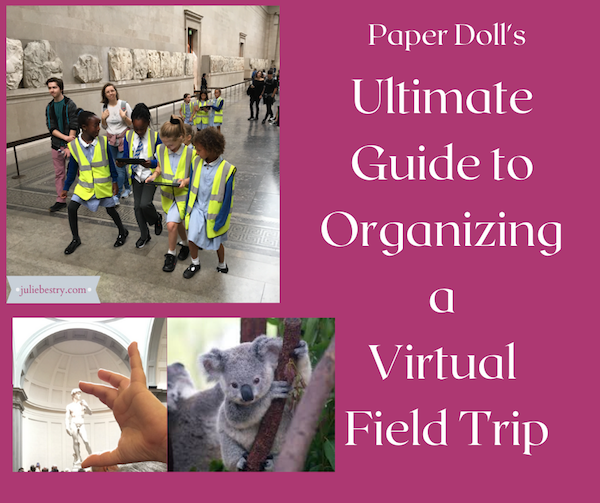 Do you remember the field trips you went on as a kid? Even if the trip was headed somewhere you’d been before, or someplace that wasn’t that exciting, there was something compelling about having to turn in that golden ticket of a permission slip, having a shortened class schedule, getting on a bus, perhaps having to hold hands or hold onto a rope, and getting shushed by the teacher in a brand-new environment.
Do you remember the field trips you went on as a kid? Even if the trip was headed somewhere you’d been before, or someplace that wasn’t that exciting, there was something compelling about having to turn in that golden ticket of a permission slip, having a shortened class schedule, getting on a bus, perhaps having to hold hands or hold onto a rope, and getting shushed by the teacher in a brand-new environment.
Growing up in Buffalo, I visited Tifft Farm Nature Preserve and learned how maple syrup was tapped, how maple sugar candy was made, and never to drink a beverage if your field trip is anywhere with outhouses instead of bathrooms!
As a kindergartner, I visited the Mirrored Room at the Albright-Knox Art Gallery, and was transfixed by the mirrored walls, ceiling, and furniture, although the mirrored floor terrified me. Would I fall through into another world?
Throughout elementary school, I got to visit the planetarium built right into one of the district’s newest high schools (giving me an unrealistic expectation of high school fun). And on multiple visits to the Buffalo Museum of Science, I was shocked to come face-to-face with a wooly mammoth.
Yes, my sandwich was always soggy by lunchtime, and my feet were usually tired by the time the bus returned to school, but the whole experience gave kids a burst of energy during long stretches of weeks without holidays.
Couldn’t you use a field trip right about now?
Every day, another thousand blogs tell you how to effectively work from home, entertain and education your children, and be productive on a myriad list of home projects, all during the uncertainties of sheltering in place. And certainly, Paper Doll has thoughts on all of those things. But that’s not what today’s post is about. Because you need a break. (OK, I need a break. Even professional organizers lose their motivation in these wooly mammoth times.)
While you may not be able to take a drive downtown or hop on a subway, you can still ease your mind and stir your soul. You may not be able to pop out to the library, but you can borrow ebooks from your public library. You may not be able to attend a workshop, but there are TedTalks galore. But there’s nothing like the energy of going on a field trip…so off we go!
ORGANIZE FOR A VIRTUAL FIELD TRIP
It’s far too easy to click on some links, making your experiences every bit as quotidian as clicking over to Instagram or going down a rabbit hole of YouTube videos. To make your field trip a mental, emotional, and visceral experience that feels like an adventure, follow these steps.
1) Make a production out of it. Get dressed up. Go outside, walk around the driveway, and come back in with fresh eyes. If your kids don’t have a lot of experience with museums, you can talk about how (when we go on real field trips), we don’t run, how we talk in hushed tones, and how we don’t push people, but we will be rewarded with magical experiences in huge rooms and bright colors and cool sites.
No tiny humans? You and your partner could dress in your fanciest clothes (or, y’know, not the same sweats you’ve been wearing all week) and agree to make the trip as vivid and special as possible. No stopping to check Twitter, no doing laundry.
On your own? Make it less of a solo excursion by sharing the experience with friends. Post a photo collage of yourself, your lunch (of which, more later), and the home screen of your visit’s location. “I’m going to the Louvre today. Ask Me Anything!” Periodically, post something surprising that you’ve learned. Even if you’re alone, you don’t have to be lonely on your field trip.
Even if you're alone, you don't have to be lonely on your field trip. Click To TweetMake time for your trip. Don’t just sandwich a quick whirl through the web between working on your sourdough starter and bingeing the next episode of Kitten Prince. (OK, I know, but I’m not giving that show any more press!)
Build it into the homeschool day, or schedule it for after dinner on a work-from-home Zoom-filled workday. Experiences are far more memorable than tangible things, which is why they make better gifts than things that turn into clutter. Give yourself a gift of the field trip experience.
Pack a lunch. Remember the brown paper sack lunches for field trips? Paper Mommy was always a room mother, helping corral the kids, but she tucked a note and a little doodled self-portrait into my lunch, folded in with my napkin, nonetheless. Perhaps you could tuck a little quiz or puzzle into a bagged lunch for your kids (or partner, or housemate)?
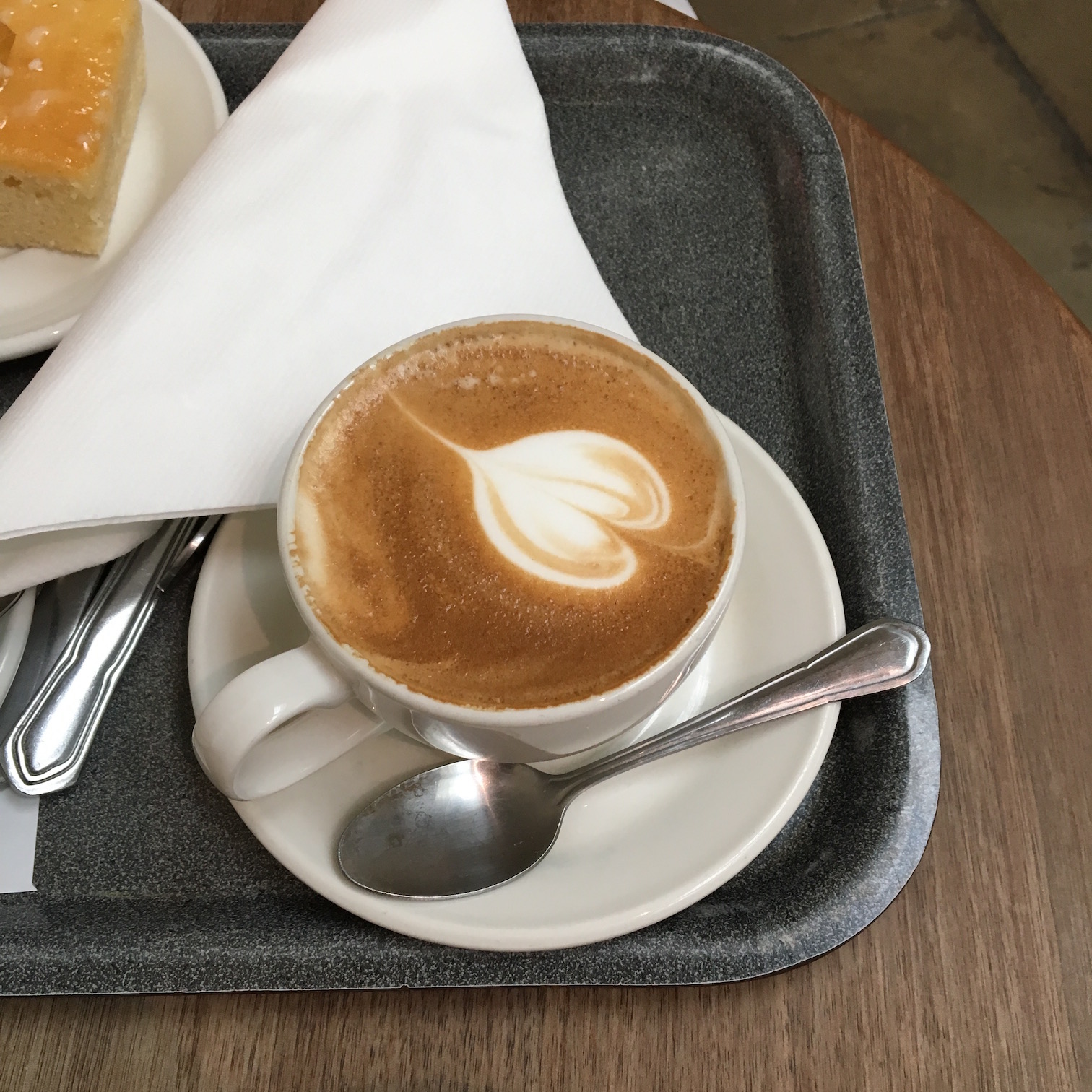
Or do the museum café thing and try to make a fancy coffee. Break out some wine and quarantine cheese, and make a night of it. When I toured the UK last September, we had gorgeous weather in Scotland, Wales, and most of England, but our only full day in London was dark and rainy all morning, and plagued with kerfuffles. Once we got to the British Museum, we were feeling a bit overwhelmed; there was too much to see in the few hours we had, and we were damp and cranky. After an hour of trying to hit the guidebook highlights (including the actual Rosetta Stone!), we stopped at one of the pop-up cafés on an upper floor, and surrounded by art, had little cakes and beverages, which refreshed our bodies and gave us verve.
You’ve been locked in for perhaps a month. Take your verve where you can get it!
Do some research. Learn things before you set off for about what you’re about to see, and wrap up with investigating more about what you’ve just experienced. If you were in school, your teacher would prepare a unit in art or Social Studies (do they still call it that?) or science so you’d know a bit before the big day.
Heading to a National Park, if only in your mind? Find out how Teddy Roosevelt helped to create the National Parks System, or sign your tiny human up to be a Junior Ranger. Going to a Van Gogh exhibit? Watch the (whole) Doctor Who episode, Vincent and the Doctor. (Grab tissues.)
Ask some questions and share your thoughts. What did you like best? What surprised you?
When I was small, Paper Mommy taught me a game where we looked at each painting in which a person or animal appeared, and we narrated what they were thinking or feeling. In general, we were snarky, but I’ve now played this game in every museum or art gallery I’ve ever visited, from Chattanooga to Chicago, from Cannes to London to Florence, making up a cinematic backstory for every “character” or scene played out in grand paintings and sculptures.
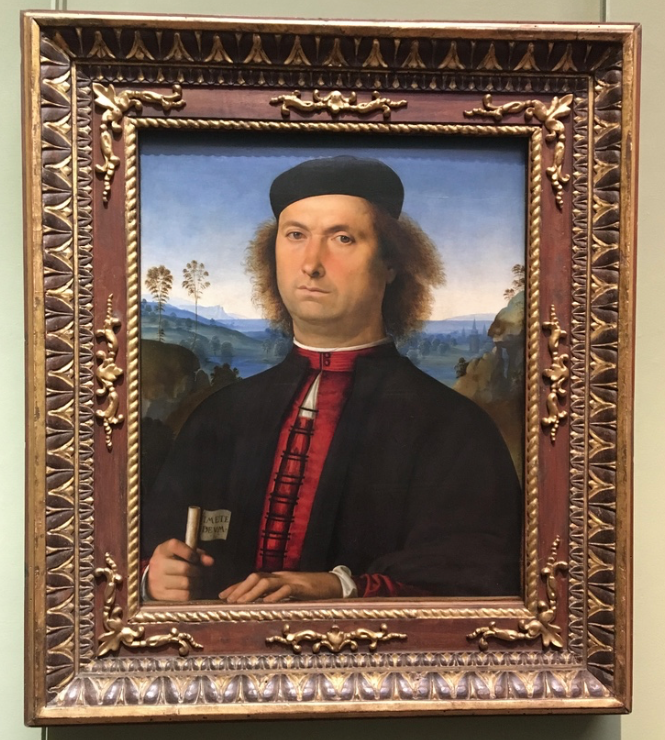
(What do you think he’s thinking?)
Visiting sea or land creatures on your virtual visit? Talk to your kids about what you learn, and ask them to compare or contrast aspects of how the animals care for their young or live with their families to the way humans do it. With a fellow grownup? Discuss aspects of animal life you wish more humans embraced. Or, y’know, talk to one another in faux animal voices. You do you, boo!
Thinking and wondering, rather than just looking, makes your field trip (and the things you saw on it) much more vivid.
Make a plan for a real field trip in the future. Quarantine will end. Someday, we will be traveling again, visiting again, vacationing again. Use what you learn on your field trips to make some proactive, mindful plans to help you hold on to your vision of the future.
Visit the gift shop. No field trip is complete without looking through the tchotchkes being sold. Some places, like the MOMA, have gift shops that rival Amazon for the amazing things you can acquire. But by visiting virtually, there’s no pressure to quickly decide between making a purchase or missing out. (And most museum shops, like the Musée Dorsay store, has temporarily suspended shipping orders, anyway.) Bookmark the product page, and you can always return to buy 24/7 if there’s something that captivates you days or weeks after your field trip.
The rest of this post is designed to give you a whole host of thrilling options for your field trips, but please feel welcome to share your own favorites in the comments. Where have you visited? Where will you go?
EXPERIENCE THE WORLD’S NATURAL BEAUTY
One of the most exciting ways to travel while sheltering in place is via one one particular new exhibit and interactive documentary from the increasingly cool Google Arts & Culture project. It was launched this spring to celebrate the Centennial of the National Parks Service. (Thanks, Teddy!)
These are no mere coffee table book photos. You can take 360° tours of U.S. National Parks. You probably know a little (or a lot) about the big ones, like the Grand Canyon (yes, even if all you remember is what you saw that Brady Bunch episode!) or Yosemite.
But this exhibit concentrates on the parks you might know less about, like Alaska’s Kenai Fjords, New Mexico’s Carlsbad Caverns, Florida’s Dry Tortugas (which sounds like a food truck menu item), Utah’s Bryce Canyon, and Hawaii’s volcanoes.
Of course, once you start searching for virtual field trip options in the world of nature, the opportunities seem boundless. Consider the Nature Conservancy of Oklahoma‘s OK360° guided tours and hikes.
Wish you could commune with nature? Take a virtual dive with the National Marine Sanctuaries and visit some watery depths from American Samoa to the Florida Keys to the Olympic Coast. Virtual dives let you see an underwater habitat (and even some sunken treasures) using only your computer, phone, or virtual reality headset.
Be cure to check out nature-oriented livestreams, too, like:
The Cincinnati Zoo and Botanical Garden, where you can visit with Fiona, the baby hippopotamus.
The Georgia Aquarium’s African Penguin webcam; you can also visit the tuxedoed birds’ neighbors via the beluga whale, alligator crossing, and piranha webcams!
The world-famous San Diego Zoo’s webcams — apes, baboons, burrowing owls, condors, elephants, pandas, polar bears, tigers, butterflies…take your pick, but right now, I’m sticking with their koala cam!
The New England Aquarium’s virtual visits follows along as the penguins are fed or the giant ocean tank is cleaned, and there’s a YouTube playlist of all of the NEAQ’s virtual visits.
Canada’s Farm Food 360° offers eleven virtual tours, from dairy cow and egg farms, to sheep and pig farms, to grain farms and feed mills. Sometimes, nature isn’t just there to be seen, but to help sustain us as well.
And if the natural world of days gone by is more your field trip style, take a jaunt through the online exhibits of the Smithsonian’s National Museum of Natural History. Perhaps you’ll feel less like a dusty fossil after a panoramic view of some old bones (and butterflies, and gems, and ancient history).
TAKE A VISIT TO THE ART MUSEUM
Not really an outdoorsy person or an animal lover? (Paper Doll feels your pain.) You can focus your mind with art!
Start with Google Arts and Culture’s Uffizzi Galleries, where you get the Google “street view” of Florence, Italy’s most famous art gallery. (I visited the Uffizzi in 2018; it’s breathtaking, in terms of both the art and the views of the city through upper floor windows, but I’m sure this virtual visit is less exhausting.)
Not all tours need to be 360° visits. Sometimes, you want to see things up-close and personal. Paris Musées, a group of 14 Paris museums, including Maison de Balzac, Petit Palais, and Maison de Victor Hugo, have made high-resolution digital copies of 100,000 artworks freely available to the public on their collections website. Look at everything (making a daily lunchtime field trip) or stare at one work, transfixed, like Cameron at the Chicago Art Museum in Ferris Bueller’s Day Off. (While you’re at it, read what filmmaker John Hughes had to say about those scenes!)
Weren’t we talking about Van Gogh a little while ago? Amsterdam’s Van Gogh Museum, which houses the largest collection of the tortured Post-Impressist master, has put nearly one thousand of his paintings and drawings online and developed a Van Gogh At Home teaching program to help parents share art with their children.
So even if you feel like you haven’t been out of your house in 132 years, you can snuggle under a blanket and view Van Gogh’s 1888 The Bedroom from the comfort of your own room.
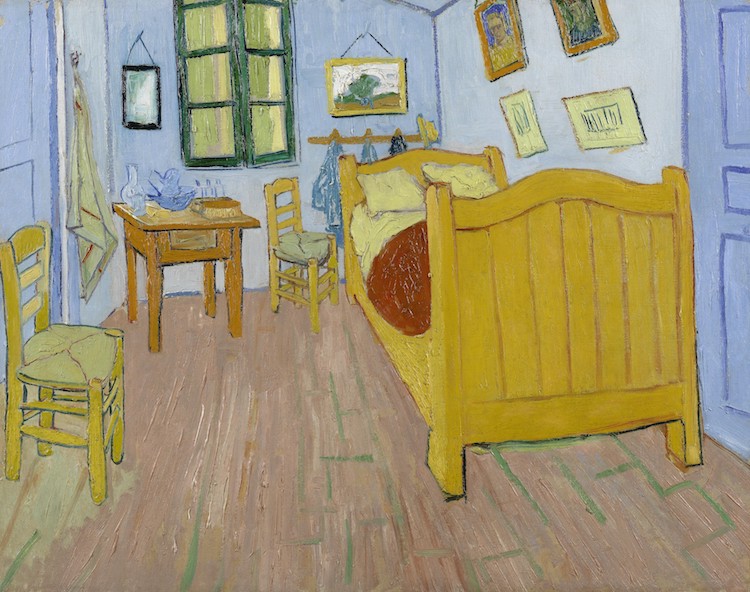
Other amazing options for an art-related field trip:
The Solomon R. Guggenheim Museum in New York, NY.
The Art Institute of Chicago in Chicago, Illinois.
The National Gallery of Art in Washington, DC. (One current virtual tour is Degas at the Opéra! Also check out Google Arts and Culture’s panoramic tour of the NGA.)
The Smithsonian’s National Portrait Gallery in Washington, DC. (In addition to the Google Arts and Culture tour, the NPS has designed a “Visit at Home” program.)
Always wanted to visit the Louvre? Open Culture has gathered three high-definition videos from Wanderlust Travel Videos so you can see Mona Lisa‘s smile, but also many lesser-known works.
Musée Dorsay in Paris, France.
Tate Modern in London, England – From the Bath of Psyche to 500 Years of British Art, you’ll have your pick of views.
The British Museum in London, England is huge and glorious. And exhausting. But they’ve developed 11 tips for exploring from home and you won’t have to jockey for a view of Rosetta Stone.
Is this feeling too highbrow for you? What about a Google street view of 12 Banksy murals?
Maybe you don’t even want to take a field trip to see the art, per se, but you just want to see art about the art? The Metropolitan Museum of Art in New York City has developed a map of the museum for the whole family. (Scroll down, then read the article at Atlas Obscura.)
Don’t feel like even thinking about where to click? Just want the experience to wash over you? How about this 5-hour, one-take journey through St. Petersburg, Russia’s Hermitage Museum. 45 galleries, 588 masterpieces. Sure, it’s basically an ad for Apple’s iPhone 11, but it’s worth the price of admission (which, of course, is free).
And if you don’t know where you’d like to take a field trip to see art, try the Art Camera. Pick just one piece of art (Manet’s The Conservatory? Frieda Kahlo’s Self-Portrait With Monkey? Rembrandt’s The Night Watch?) and get up-close and personal with just one painting, learning every brush stroke.
GET SOME PERSPECTIVE FROM YOUR COUCH
It’s easier for art museums to put their collections online. History museums and interactive exhibits are a little more complex. However, whatever fascinates you in this world likely has a museum. Try firing up your search engine and typing in the subject, the word museum, and “at home” or “virtual” to see what comes up.
The Smithsonian’s National Museum of African American History and Culture has video resource guide for exploring their archives available from home. This might be the perfect time to participate in the Community Curation Project, sort your photos, and find your family’s history in American history.
The Smithsonian’s National Museum of American History has over 100 online exhibits. They aren’t all ready-for-Prime-Time, but if history is your jam, field trips to the past will keep you busy for so long, you’ll forget that you’re sheltering in place while you’re traveling in time.
The National Women’s History Museum has a wide variety of exciting online exhibits on topics as wide-ranging as the women of NASA to women in Congress, from women who campaigned for suffrage and civil rights to women who waged World War II.
Things will get better, so consider signing for memberships with your local cultural venues. Time Travelers is a reciprocal membership network for historical museums and societies throughout the United States. Members of historical institutions can receive exclusive benefits and privileges at museums and historical sites nationwide, including free or reduced admission, gift shop discounts, free parking, and much more. Your local museums, zoos, and other venues likely offer similar reciprocal opportunities.
GRAB SOME LITERATURE WITH YOUR LATTE
Perhaps a poetry reading is more your style? Patrick Stewart has been reading Shakespearean sonnets, most in numerical order, each day. (He declared that #5 was “too hard.”) Here’s just one.
Sonnet 3#ASonnetADay pic.twitter.com/hI4GzH49P8
— Patrick Stewart (@SirPatStew) March 24, 2020
EVERYONE IS BEAUTIFUL AT THE BALLET (AND THE OPERA, TOO)
You already know about music streaming services like Spotify and Amazon Music, but what about visiting the opera or taking in some classical music?
The Metropolitan Opera is offering nightly streams of operas, as well as free streaming events for students.
London’s Royal Opera House has a massive YouTube playlist of the Royal Opera and the Royal Ballet. The sidebar includes affiliated groups, like the Welsh National Opera and the Scottish Opera.
The Berlin Philharmonic is presenting livestreams, though I’ve yet to find a translation option for English. But music is supposed to be a universal language!
AND MORE
As a professional organizer, I eschew clutter. As a curious person who fancies herself a completist, I like to collect ALL of the options.
And if nothing I have suggested piques your interest, the MCN (formerly the Museum Computer Network) had a mind-boggling list of hundreds of virtual museum resources to serve your needs: museum portals, art and cultural museums, museums of history and natural science, online exhibits, e-learning opportunities, and digital archives. Suddenly, it almost seems like quarantine won’t last long enough.
I know you probably wish you were out and about, but until we are all traveling freely about the planet, unmasked, take some time to give yourself some daily or weekly delights. Have some great field trips. Just skip the ones that only have an outhouse.
The Now Normal: When the New Normal Changes Quickly
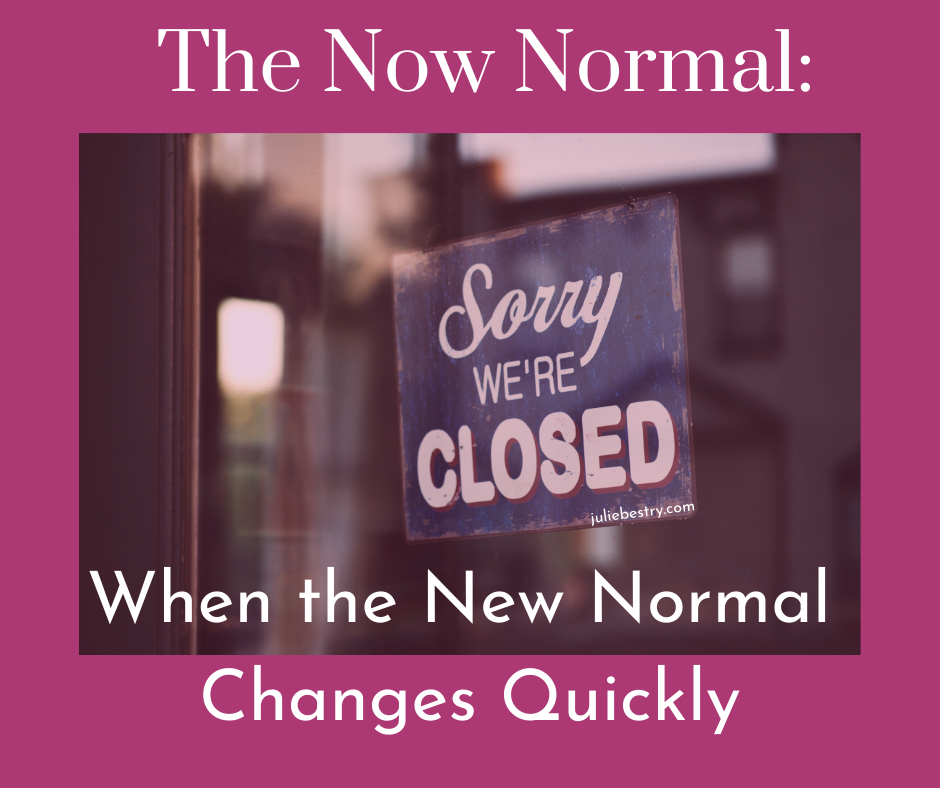
My dear Paper Doll readers:
It’s been two weeks since I posted. In that time, things in the country and in my business quickly went from cautious pessimism based on watching the international COVID-19 statistics to frozen in time. In-person client sessions and speaking engagements are canceled. Days are filled with calling and Zooming and texting to check on loved ones. And sheltering in place has joined the national vocabulary, along with extreme social distance and I’ve gained seven pounds since yesterday.
But let’s talk about sheltering in place for a moment. That’s a term we’re used to hearing when there are national disasters related to weather, like tornadoes or hurricanes. It’s something we do for an hour, or perhaps a day. It’s not something we expect will control our work and personal lives for weeks or months to come. And as we hear sirens, we may fear destruction of property, but we generally assume that insurance will protect us financially.
[Not to get too political, but have you noticed that nobody tells corporations to stop eating avocado toast and giving billionaire CEOs golden parachutes and to put some money aside for troubled times? But we’re left to fend for ourselves and pay rent, mortgages, utilities, and other bills when the entire world comes a halt? Just sayin’.]
So yes, in these days, these early days, we’re all feeling a little raw. And while it’s starting to seem like that odd week between Christmas and New Year’s, when we don’t know whether it’s the weekend or garbage day or whatever, it really is still early days. While last week was the first week at home for many, this week will be the dawn of this new reality for others.
Where You Are
If you have a “knowledge worker” job or a similar corporate existence, you’re having to set up a working office at home and figuring out how to balance your work day without break room doughnuts and your “office spouse” who keeps you in stitches. You’re also realizing that at least you won’t have dry cleaning bills for a while.
For you, the internet is replete with advice for being focused and productive while working from home. I’ve written a lot about that, like 5 Keys to Focus, or What Lord Chesterfield Knew About Multitasking, and eventually, I’m sure, I’ll be writing more of those posts, too. (But if you’d rather laugh, How to Work from Home Most Chaotically will loosen that knot in your neck and start you using the term “chaos muppet.”)
If you’ve been working from home all along, whether for pay or otherwise (and it’s good that people are finally realizing that at-home parents — and teachers — are miracle workers!), you’re likely struggling to maintain focus, both because the world is spinning, but also because your partner or tiny humans or others who are usually out during the day are driving you cuckoo for Cocoa Puffs.
Some of you suddenly realize that your spouses think of themselves as visitors, needing to ask you where to find everything from coffee to staplers. Others of you may find that your partners have become that manager from Office Space, bringing their work attitude to bear and passive-aggressively telling you how to run the household, a job you’ve been handling for years or decades. (“I’m gonna need you to start stacking the yogurts by flavor, subcategorized by expiration date. Yeah, that would be great.”)
(Check in with your moms and grandmoms, aunts and older family friends; this is something they may have experienced when their husbands retired, and they may be able to advise you on how to prevent yourself from becoming the title character in a 2025 movie of the week, “Love and Murder In the Time of Corona.”)
And some of you have time-traveled back to an era you thought ended when your kids went off to school. You’re expected to entertain and educate and dazzle your entire family, becoming a 24/7 cruise director on the Good Ship Quarantine. My next post is going to help you organize those activities so you can feel a little greater sense of peace. But let’s focus on now.
The Now Normal
Whoever, wherever you are, even if you’ve kept anxiety over COVID and your loved ones at bay, you’re probably anxious. Everything feels strange, like a dream you had while getting your wisdom teeth pulled. The old rules feel like they don’t apply.
This post was inspired by my colleague Seana Turner’s excellent (and comforting) Reconsidering Productivity. Seana gave great advice, but she said, “this is the new normal.” But I think it’s not. It’s the now normal.
A little over a decade ago, I had a health crisis. Overnight, I had to stop seeing clients, and often could not leave my home. Over the course of that year, I had six hospitalizations, two transfusions, and three surgeries. I was worried about my health, my finances, and keeping up a cheery disposition for the people who loved me. Every few days, just as I’d get used to dealing with things, another shoe dropped. (I began to wonder if the clouds were seeded with well-dressed octopi!)
And every once in a while, the people closest to me would get hit with a barrage of sternly worded exultations. (Um. If you know what I mean.)
During this time, I learned that there is no new normal. There’s only the now normal. Eventually, we have to accept that the sand may shift under our feet.
But there are still some certainties.
Our loved ones may have their own sternly worded exultations, but they will find their centers and regroup. That’s one good thing about the hedonic treadmill! The other thing is that we’re not tempted to hang clothes on it.
Our favorite books are still a source of comfort. Even our annoying coworkers are familiarly annoying in the same ways as always, only now over Zoom.
Contradictory Advice
What does this have to do with organizing? As I always say, organizing isn’t about the stuff, it’s about the person who owns the stuff. And sometimes, that stuff isn’t in your living room or on your calendar. It’s in your head. And my head. And your annoying coworker’s head.
In the coming days, as we struggle (together and separately) to navigate the ever-changing seas of abnormality, I’ll be providing my best guidance (and a lot of links to my colleagues’ wisdom). Sometimes, the advice we give will conflict, and we must accept that as normal, too, because different situations, different people, even different days will require different advice. For example:
Add structure to your day (with time blocking, with the Pomodoro method, with alarms on your phone and smart devices), but
Be flexible (and don’t make the schedule so rigid that you feel like you are are living at the office or at school)
Or:
Focus on familiar work projects (and try to ignore that nothing feels familiar except that you’re having your regular Monday stand-up meeting but you can’t stand up because you’re wearing pajama bottoms), but
Use this as an opportunity to create (and wonder why you can’t write that Great American Novel you said you’d write if you ever got furloughed or laid off or finally retired because your house is filled with pandemonium (or deafening silence) and every time you rest your chin on your hand to think, your inner voice screams “Don’t touch your face!”)
For today, I’m going to leave you with only one piece of advice.
It’s OK to Not Be OK.
You don’t have to organize your closet or come up with a new home-based side-hustle. At least not today. Maybe tomorrow.
I don’t know if you need a random internet blogger’s permission to muddle through for a bit and not actually be productive, but if you do, you have mine. Wait to see what the now normal is when later becomes now.
And a Special Announcement
A week ago Sunday, I got a phone phone call from Dr. Melissa Gratias, asking me to participate in her new project. You may remember when I interviewed her last year about Seraphina Does Everything, her children’s book on activity overwhelm. Melissa’s experience as a psychologist dovetailed with her love of writing for children, and she’s created something special for these confusing times.
Melissa has written and released a free children’s ebook entitled Captain Corona and the 19 COVID Warriors. In the vein of the oft-quoted Mr. Rogers’ “Look for the helpers” advice, Melissa’s book gently explains to elementary school-aged children what’s going on right now, focusing on honoring all of the people collaborating to help during this crisis. Melissa partnered with illustrator Brittany Curry to create the book in a matter of ten days, and I am honored to have played a small part as the book’s editor.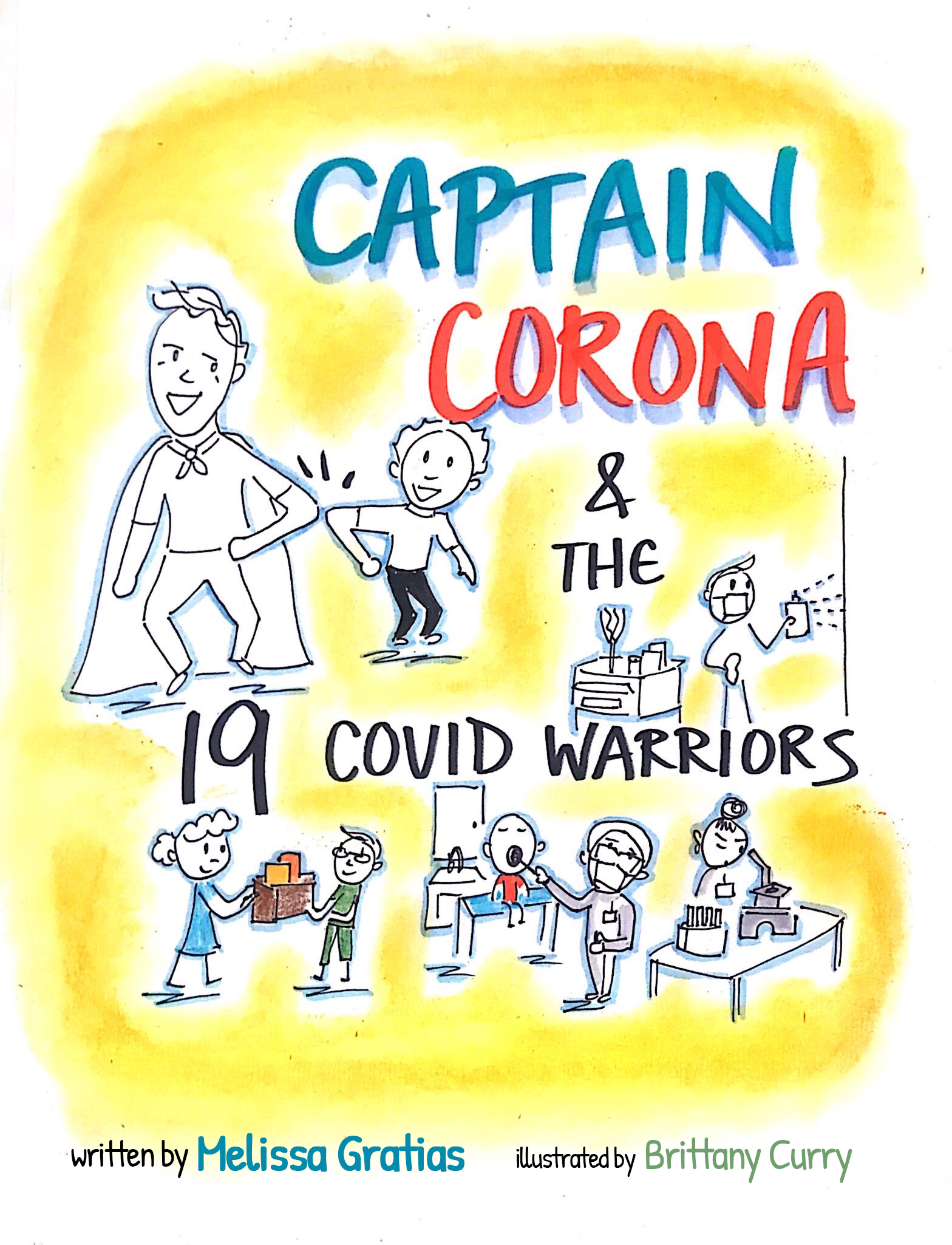 The publishing world is complicated, and Melissa didn’t want any barriers between readers and this book, so she has made it available at no cost as a free download from her site. However, Melissa encourages everyone to donate to the Center for Disaster Philanthropy’s COVID-19 Response Fund, an international organization that seeks to “support preparedness, containment, response and recovery activities for those affected and for the responders” or to the non-profit of their choice.
The publishing world is complicated, and Melissa didn’t want any barriers between readers and this book, so she has made it available at no cost as a free download from her site. However, Melissa encourages everyone to donate to the Center for Disaster Philanthropy’s COVID-19 Response Fund, an international organization that seeks to “support preparedness, containment, response and recovery activities for those affected and for the responders” or to the non-profit of their choice.
I encourage you to download this book and share it with the tiny humans in your life. It will remind them, and you, of all the people working to get us back to “normal.” Until then, I wish you health and safety as you navigate each day’s now normal.
Yours truly,
Paper Doll
Julie Bestry, Certified Professional Organizer®
Organize to Help First Responders: The Vial Of Life
Last time, we talked about the importance of being able to communicate vital medical information to first responders when we’re on the road. Having that Yellow Dot on the car means that even if you (or your passengers) are unable to communicate, paramedics will know where to look – in the glove box! – for information that will save precious time and ensure the correct treatment.
But what about when you’re not mobile? What if you (or Grandma or someone else with serious health issues) get ill at home and emergency services are called. What if you (or they) can’t explain medical history to first responders. As we discussed last time, it’s never comfortable to talk about these things, but thinking about them in the present can make the future a bit less stressful.
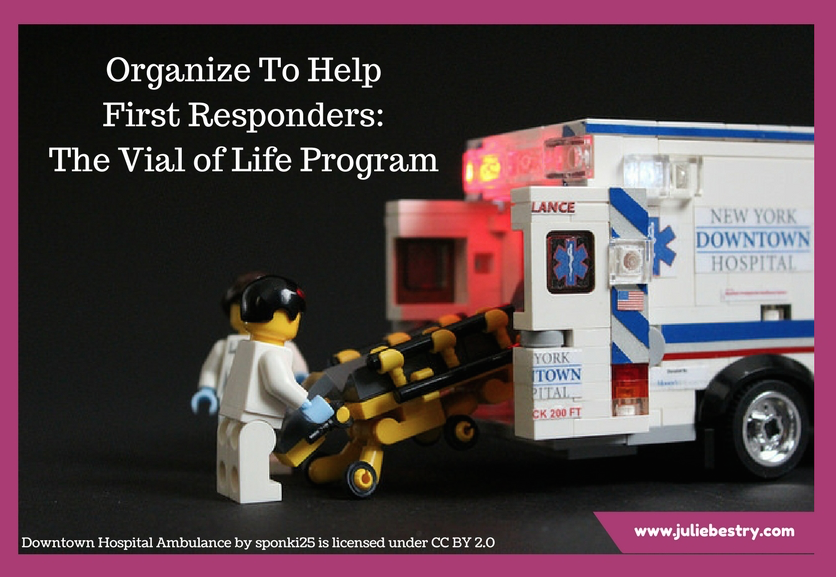
“Downtown Hospital Ambulance” by sponki25 is licensed under CC BY 2.0
Certainly, you can (and should) keep careful medical records and have them available so that loved ones and medical professionals can help you in an emergency, as we discussed in Paper Doll on the Smead Podcast: How To Get Organized When You Have a Chronic Illness. But having a tidy binder or a medical file doesn’t help you if the paramedics don’t know where to find it.
VIAL OF LIFE
The Vial of Life, where “LIFE” stands for Lifesaving Information for Emergencies, is a program that enables you to collect all of your essential medical information, keep it accessible to first responders, and includes an attention-getting flag so it can’t be overlooked. As with the Yellow Dot Program, the Vial of Life is designed to speak for patients when they are unable to speak for themselves. Vial of Life is most commonly used by senior citizens, but anyone with medical conditions that could trigger an inability to communicate (such diabetes, epilepsy, heart disease, etc.) could benefit from participating.
The elements of the Vial of Life kit are also similar to those of the Yellow Dot. You’ll need:
- a sticker or decal, usually placed on the front of the refrigerator, to alert first responders that there’s a container in or on the fridge
- a labeled vial, much like a medicine bottle, kept in the front of the fridge; recently, the literal vial has been replaced in many communities by a zip-lock plastic bag or plastic/vinyl pouch attached to the front of the refrigerator)
- medical information forms, folded and rolled into the vial (or placed flat in a bag or pouch), containing vital medical information
The materials are typically free, and the forms can usually be downloaded from the web and printed.
First responders throughout the US and Canada have been trained to look for a decal or sticker at the entrances to homes and/or on the front of the fridge.
Public Service Announcement: The less clutter on the fridge – the fewer year-old wedding invitations and expired oil change coupons – the easier it will be for first responders to see the Vial of Life decal.
HOW TO PARTICIPATE
There are a variety of regional and agency options for obtaining your Vial of Life kit. Google “Vial of Life” and your community name; if your local hospital, pharmacy, or community groups aren’t offering resources, the most straightforward way is directly through VialOfLife.com.
Go to VialOfLife.com.
Order UV-coated vinyl decals for your home online or by calling 888-931-1010. (You can purchase bulk order kits for your organization.) Alternatively, you can print your own stickers directly from the Vial of Life site onto adhesive-backed paper.
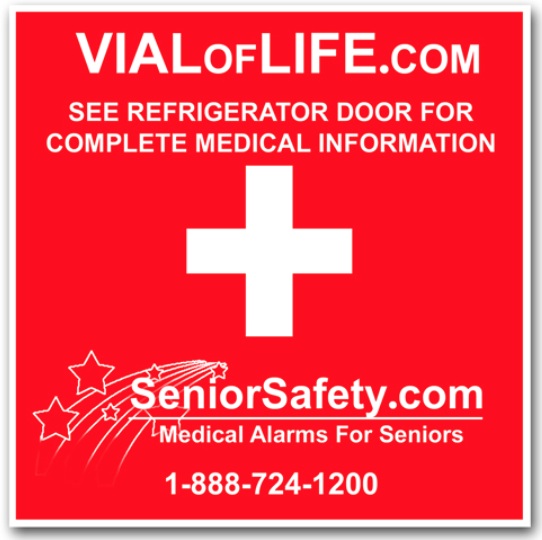
Create an online account. Provide your email address and create a password, and then give your name, mailing address, and phone number(s). You’ll be asked whether you want to participate in the First Responders Program, which gives medical personnel remote access to your information during an emergency.
NOTE: You don’t have to become a member, but if you do, you can update your information online as your prescriptions and medical situations change. If you choose not to become a member, any time you want to update your medical or personal information, you can print multiple copies of a blank form to fill in by hand, or return to the site to re-enter everything and print a typed copy. (View the site’s privacy policy here.)
Log in with the credentials you just created.
Create a new Vial of Life. Once you log in, you’ll be prompted to create a new vial. You’ll be asked for four types of basic information:
- Basic information
First, re-enter your full name and contact information. I’m not sure why this information can’t be directly imported from your account creation, but I suspect it’s to allow one person – a wife, for example – to create one family account and then create separate vials for herself, her spouse, and perhaps a grandparent or other person residing in the home, all without creating additional accounts.
You’ll also enter your gender, height, weight, hair color, blood type, and religion (much as you’d fill out in any hospital admittance form). There’s a section for adding whether you use a pacemaker or defibrillator (and a space for inputting the model number) or hearing aids, and for noting hearing impairment.
The next section asks about vision, whether you wear glasses and/or contact lenses, if you are blind in either eye or if either eye is artificial, and what your native language is. (Paper Doll would like to note that all of this information is useful, but it’s perhaps not entirely well organized. Harrumph.)
- Medical history
This section has two essay-style boxes. The first asks if you have any identifying marks, ostensibly to better identify who the patient actually is. The second asks, broadly, for all the conditions for which you’ve been treated in the past. (Again, Paper Doll isn’t in love with the organizational system here, and would prefer if the official program had a series of prompting checkboxes to ensure that users don’t forget any vital health events.)
- Current medical information
This section asks for your doctors’ contact information, the conditions for which you’re currently being treated and your current medications. The form does not ask for dosages, but I suggest you list both dosages and the frequency with which you take these meds. Where the form asks whether you have any medication allergies, if you are allergic to latex, I encourage you to list that, too.
The current medical information section has spaces for information regarding your last hospitalization and your medical insurance policy information. There are sections for noting whether you have a living will and whether you are an organ donor (and to whom medical professionals should speak regarding each issue).
- Emergency contact
The form has spaces for the name and contacting information for your emergency contact and what their relationship is to you.
I should note, another great unofficial program is listing your emergency contacts in your cell phone as ICE (in case of emergency). My phone, for example, lists “ICE Paper Mommy (and her contact info).”
Take a moment to add one or two of your emergency contacts to your cell phone directory. Just type ICE in the last name section and the person’s entire name (and perhaps their relationship to you) in the first name section. This way, if first responders check the I’s in your contact list, they’ll see ICE right away.
Once you fill out the form, you can save it (if you have created an account) and print the form. If you choose to save, the system will return you to a screen giving you the options to edit, print, or delete the vial you have saved.
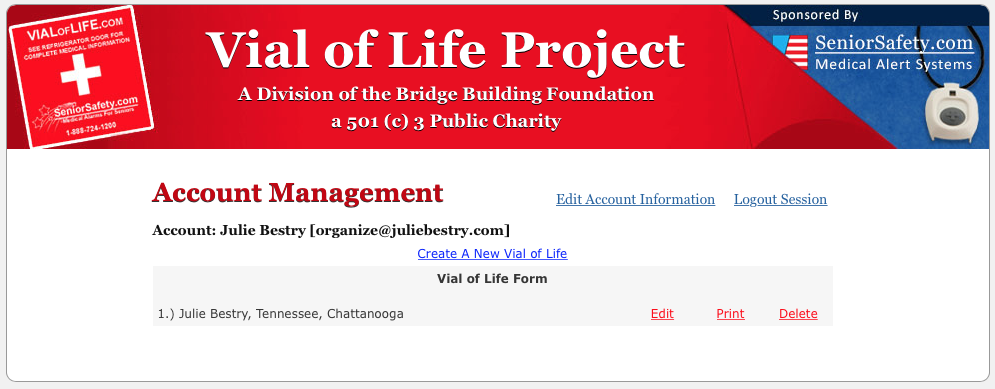
THE NEXT STEPS
Put your Vial of Life together.
As I mentioned, some versions of the Vial of Life use an actual vial, but the Vial of Life Project recommends maintaining all of your information in a zip-lock bag. (If you get a kit from a community organization, you may be given a branded vinyl pouch.) Fold or roll the form (so it fits) and add any other pertinent information, including a DNR (Do Not Resuscitate) form, a recent photo of yourself, a recent EKG, your living will, and anything else you think might be pertinent.
Affix a Vial of Life decal to the baggie or vial.
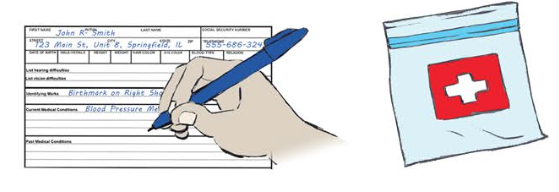
Store your Vial of Life so it’s visible!
If you’re using a vial/bottle, place it in a very visible space on a high shelf. Don’t hide it among the eggs and soy sauce packets!
If you opt for the baggie, attach it to the front of the fridge. The Vial Of Life Project recommends doing so with tape, which probably won’t be aesthetically pleasing, so you might want to use a magnetized clip, such as those used for chip bags or for attaching papers to your filing cabinet. (The vinyl pouches tend to be magnetic.)
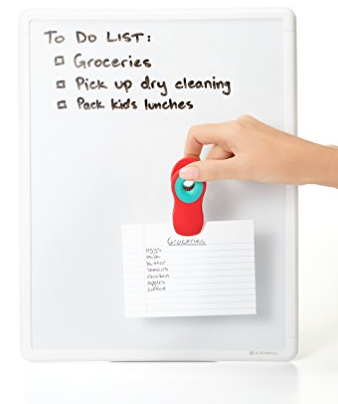
Attach the baggie or pouch near eye-level so it can be spotted quickly. (Your local first responders may have specific recommendations, such as to attach it to the top left side of the front of the fridge. Call your local firehouse to ask what they prefer.)
Affix a Vial of Life decal to your front door or in a highly visible front window (much like you’d affix a security company decal).
HISTORY OF VIAL OF LIFE and OTHER OPTIONS
The origin of the Vial of Life isn’t well-documented. We know that someone started putting vital information into medicine bottles and attached them to the interior of the fridge in a visible manner. Word spread over the years, and various community programs started offering advice on how to create a vial. Eventually, the Sacramento chapter of the American Red Cross handed off their resources to Vital-Link, Inc., one of the early “I’ve-fallen-and-I-can’t-get-up” medical alert companies.
For twenty years, the Vial of Life Project has operated as a 501(c)(3) non-profit and supplies free Vial of Life kits and decals/stickers to individuals and partner organizations, including senior citizen groups and community centers, pharmacies and hospitals, government agencies, towns and cities, Red Cross chapters, and various volunteer groups. (The American Senior Safety Agency, a medical alert company, covers the cost of the decals.)
The Vial of Life Project isn’t the only game in town. It’s founder specifically left the Vial of Life name in the public domain so that the program could be duplicated and used by other agencies and organizations. Although it’s the best-known, and costs nothing for individuals, there are a variety of alternative options, such as the File of Life.
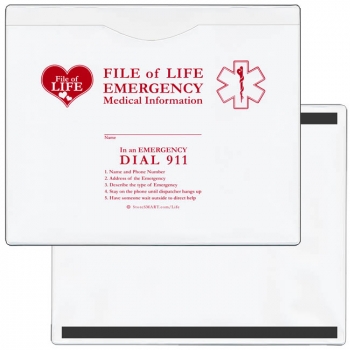
StoreSmart, the same company that offers unofficial Yellow Dot stickers and envelopes, sells vinyl, magnetic-backed, closed-sided medical information pouches suitable for displaying at your home or office. They also sell window/door stickers and have free, downloadable medical information forms.
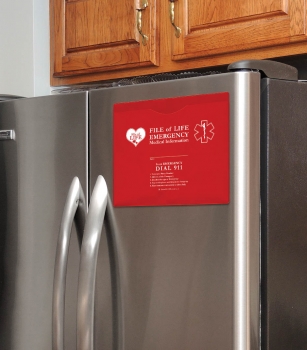
Whether you order the official Vial of Life, get a branded kit from your local hospital, pharmacy, or community group, purchase an alternative, or make your own, consider using the Vial of Life and encouraging your loved ones to do the same
Be healthy, be safe, and be organized.
Organize To Help First Responders: The Yellow Dot Program
Most of us spend time thinking about how to prevent medical emergencies. We try to exercise and eat healthily. We make doctor’s appointments, get all of the appropriate medical screening tests for our age group and gender, and we learn how to manage our health conditions in hopes of preventing complications.
Nobody likes to think about medical emergencies, but for the same reason we buy insurance (whether auto, home, health, or, in the worst case scenario, life insurance), we need to prepare for the unexpected. And when the unexpected does happen, we depend on first responders, particularly emergency medical technicians and paramedics, who have the training necessary to help us get safely treated.
So why not help the helpers?
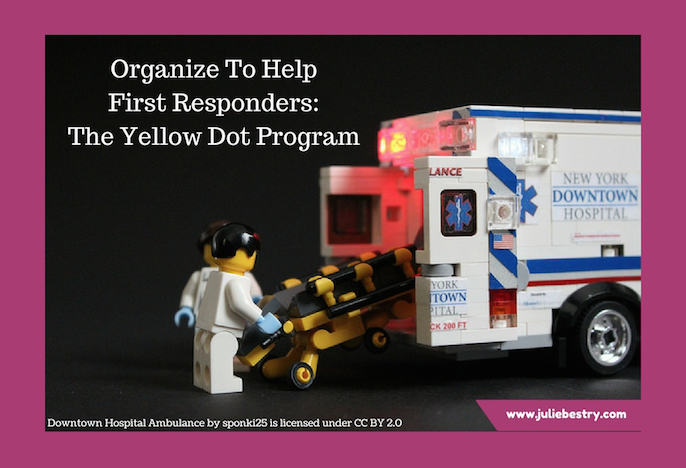
“Downtown Hospital Ambulance” by sponki25 is licensed under CC BY 2.0
In our next two posts, we’re going to look at two resources to organize essential medical information so that first responders can render aid when we need it, whether we’re out and about, or at home.
YELLOW DOT PROGRAM
At a DiabetesSisters meeting a few years ago, someone mentioned the existence of Tennessee’s Yellow Dot program, but almost nobody in the room was aware of this life-saving project.
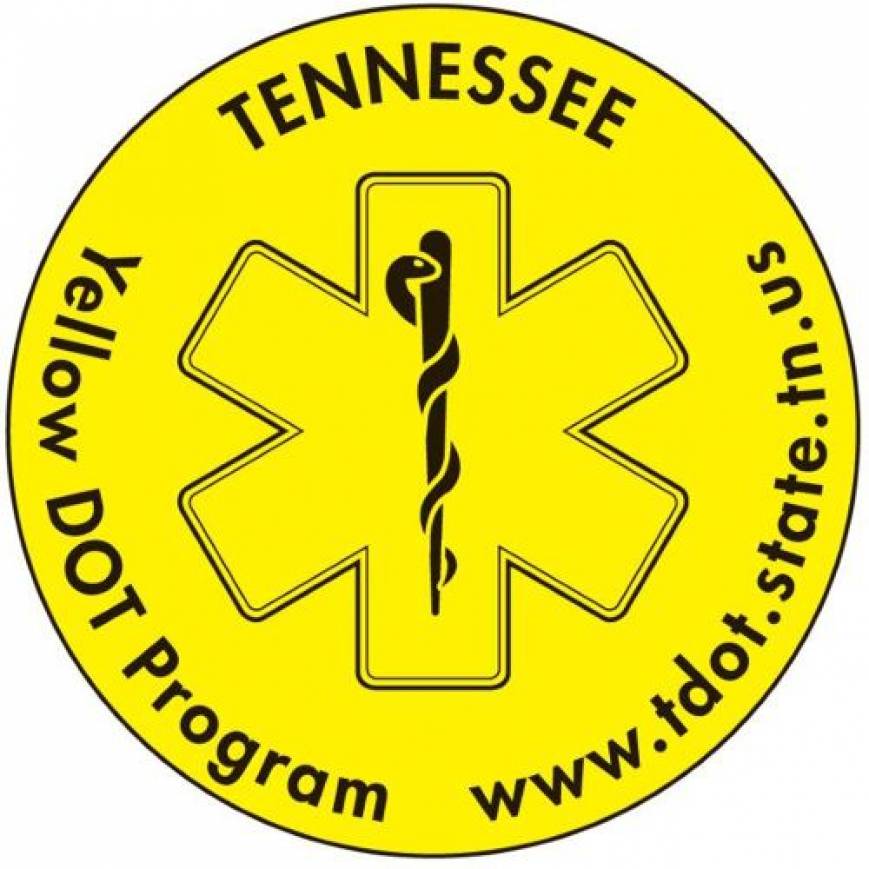
The Yellow Dot Program, available at no cost to participants, was initially developed as a regional program in the early 2000s. It is now a national program sponsored and funded by the United States Department of Transportation as a result of the work of the 113th Congress, the bill having been introduced by West Virginia’s Senator Joe Manchin III.
The purpose of the program is to help automobile drivers and their passengers communicate vital information to medical personnel (as well as police, firefighters, and other first responders) during road emergencies, like car accidents.
In case drivers or passengers are incapacitated, in shock, or are otherwise unable to communicate about their medical conditions, car owners can affix yellow stickers to their rear windshields to alert first responders that occupants of the car may require specialized medical attention. (Smaller stickers are available for motorcycle use.) Although state programs tend to accent Yellow Dot for use by senior citizens, anyone with a serious health condition or atypical health situation should consider making use of the program.
The stickers let first responders know to look in the glove compartment for a kit: a yellow plastic folder, container, or envelope. In it, they will find information regarding:
- the medical conditions, allergies, recent surgeries, and special needs of anyone riding in the car who might require special care
- lists of current prescriptions, dosages, and prescribers
- emergency contact information
- a photograph of the person so that he or she can be quickly identified as needing special attention
The Yellow Dot Program maintains no centralized database at any government or community level, so individuals concerned about privacy breaches should feel at ease. The information is maintained in the glove compartment and is not accessed by anyone (except the owner or passenger of a vehicle) unless there is an emergency situation.
At the meeting where I first learned about the Yellow Dot Program, we talked about the importance of police and medical personnel knowing that someone in the car might be suffering from hyper- or hypoglycemia, which can appear to the untrained eye to resemble drunkenness, stroke, dementia, or other health conditions.
Research shows that 90,000 to 100,000 individuals die each year due to adverse drug reactions, some of which result from standard treatments “in the field” to which an individual may be allergic. Similarly, an accident victim who has had a recent surgery may be at greater risk for complications, and first responders need to know that.
HOW TO PARTICIPATE
If you know someone who has a medical condition that might require special on-the-scene treatment by EMTs and paramedics, encourage them to sign up for the Yellow Dot Program. Management of the program varies by location, and though it’s overseen by state Departments of Transportation, management often occurs at the county level.
While some programs allow online sign-up, other communities require that participants come to an enrollment station or registration center (often at the nearest DMV, although some local businesses sponsor the printing of Yellow Dot stickers and kits and help enroll participants). Help your loved ones gather the vital paperwork – including medical and prescription information and a current photo – to put in the yellow folder to be kept in the glove compartment, and make sure you or they actually put the sticker on the rear windshield!
Although the Yellow Dot Program is funded nationwide, it is voluntary, and many states have declined to participate; other states have shown interest but have not yet rolled out their programs. If your state is listed (below) without a link, there is likely no centralized program in your state, and you will need to call or search for your county’s transportation department or division of aging services. (Yes, Paper Doll feels this is all very disorganized at the state and federal levels! Harrumph!)
Iowa
Kansas
Massachusetts (search “Yellow Dot Program” and the name of your town rather than county)
Minnesota
New Hampshire
North Carolina
Note: In 2017, Illinois mysteriously canceled participation in the Yellow Dot Program, but encourages all drivers to register with the state’s emergency contact database, which serves a similar function.
If yours isn’t one of participating states listed belong, contact your state’s Department of Transportation to inquire if and when the Yellow Dot program will be available for you. While you’re waiting, you can purchase an unofficial National Yellow Dot Program kit (with stickers and standard or folding pockets) directly from retailer StoreSMART in various batch sizes (from 2 to 2500) or in packages of five from Walmart.
In addition to the stickers and kits, StoreSMART has free, downloadable PDF medical forms. (You can also review the websites of the participating states, above, as many, such as Alabama, have their own downloadable medical forms, accessible to all.)
COMMUNITY OPPORTUNITIES
Various communities have found opportunities to use the yellow dots beyond private vehicles. Adult day care centers for senior citizens and people with disabilities, as well as traditional day care centers for children, can make use of the program by helping individuals in their care (and caregivers or parents) develop a person-specific packet, and make copies for family vehicles, program/center vehicles, and care centers.
Next time, we’ll be talking about the Vial of Life program, and how to ensure that first responders can locate your essential medical information when they attend to you at home. Until then, be healthy, be safe, and be organized.




Follow Me